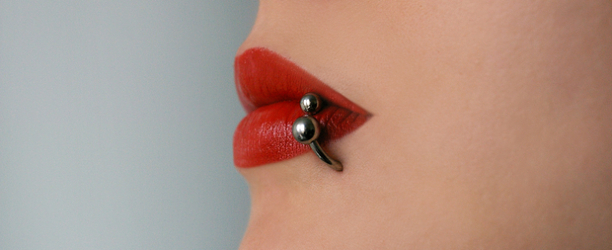Oral piercings are popular among teenagers, and are surprisingly common. Surveys of adolescents and young adults (age 13 – 29) report that 25% to 35% have a body piercing at a site other than the ear lobe. Despite the trendiness of body art, oral piercings can cause a variety of serious consequences that teenagers and parents should understand.
Oral Piercings Increase Risk of Injury
Oral piercings, particularly lip, tongue, and cheek piercings, greatly increase the risk of damaging nearby teeth. Studies have found permanent tooth damage occurred to 25% of adolescents with lip rings, and nearly 50% of teenagers with tongue piercings suffered permanent tooth damage. In addition to tooth damage, those with oral piercings have a greater risk of suffering nerve damage, oral infection, pain and swelling. The injuries associated with oral piercings are varied and oft occurring, making the small fashion statement hardly worth the risk.
Oral Piercings can lead to Disease
In addition to an increased risk of suffering oral injuries, teens with oral piercings face increased odds of contracting a disease. Multiple studies have found that oral piercings can lead to gum inflammation or gingivitis, increased plaque buildup, gum recession, cavities and metal allergies. Lip and tongue piercings have particularly strong correlations to gingival recession, according to one study.
Studies have found that the place in which the piercing was performed is another key factor influencing the contraction of oral diseases. The National Institutes of Health found that unregulated piercing parlors and techniques greatly increase the chances of contracting an oral disease, and the transmission of other diseases like tuberculosis, hepatitis and tetanus.
Stay Away from Oral Piercings
The dangers presented by oral piercings far outweigh the fashionable benefits. In fact, the American Academy of Pediatric Dentistry strongly opposes the practice of oral piercings. Speak with your children about the potential risks involved with oral piercings before they get one. If your child already has an oral piercing, make sure that they keep it clean and disinfected, and that they take it out before taking part in any sports or activities that involve contact, so that they can avoid suffering a serious oral injury.
Sources:
http://www.aapd.org/media/Policies_Guidelines/P_Pierce1.pdf
http://www.uptodate.com/contents/body-piercing-in-adolescents-and-young-adults
http://www.statisticbrain.com/body-piercing-statistics/

